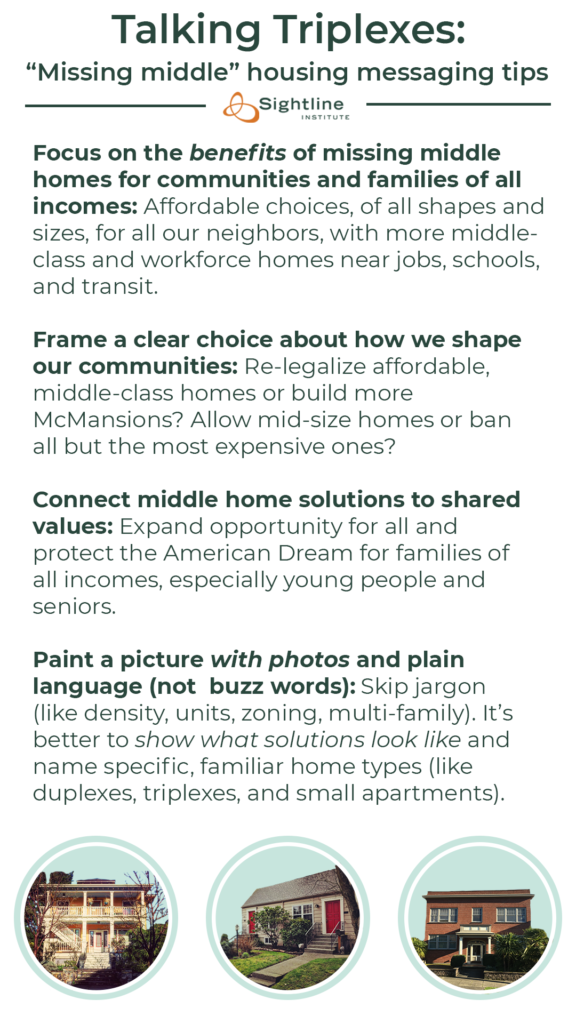Middle homes aren’t newfangled. If anything, this kind of legislation effectively re-legalizes home options that are familiar in many Northwest neighborhoods but are no longer allowed.
Editor’s note: This article was originally posted in the spring of 2019. We’ve updated it to reflect progress on two fronts: Oregon led the way in 2019, setting a floor for cities with populations of 10,000 and larger to allow a range of home types. This year, lawmakers in Washington State could follow suit with the state’s own “middle housing” legislation.
With rising inequity, homelessness, traffic congestion, and added eoncomic pressures from the pandemic, people across the state are desperate for affordable home options. But cities struggle to enact the changes their communities need. And no city can fix this widespread problem on its own.
The state can play an important role setting reasonable, effective standards with plenty of flexibility for cities to take action in ways that fit their community.
Here are our messaging notes for talking about middle housing:
Washington legislators are eyeing statewide solutions to keep job centers affordable for lower- and middle-income people, including a proposal to re-legalize a variety of home choices like duplexes, triplexes, and rowhouses in residential neighborhoods across the state. These kinds of mid-size homes help curb prices and give people more affordable options close to jobs, shops, family, and schools.
Middle homes aren’t newfangled. If anything, this kind of legislation effectively re-legalizes familiar, modest home options. Modest home types like duplexes and triplexes are already part of the fabric of North American city neighborhoods, but these familiar homes are mostly illegal to build now. They were systematically outlawed over the decades by downzoning, often in municipal moves to build invisible walls around predominantly wealthy, white enclaves. Starting in the 1920s, cities began ratcheting up restrictions on what kinds of homes could be built, and by the 1960s, most had banned everything but single-dwelling houses on vast swaths of their land—typically more than half of a city’s residential area.
Gradually returning neighborhoods to a healthy mix of homes of all shapes and sizes is a critical part of the affordability solution that so many people in this region need.
Choices about which home types are allowed and which are not shape our communities, especially by determining who can afford to live in them and who cannot. Since 1970, average sizes for new detached houses have soared by 64 percent. When cities choose to stop preventing modest home types and begin again to allow more than one home on a single lot, they can also help reverse the trend to bigger—and pricier—“McMansions.”
Here are messaging ideas to keep in mind when discussing this kind of middle housing solution:
Focus on the benefits of missing middle home choices for communities and families of all incomes: Re-legalizing middle housing protects mixed-income neighborhoods with a range of affordable choices, all shapes and sizes, for all kinds of neighbors. When more modest homes are available in our job centers, fewer people are forced to crushing, costly commutes.
Frame up a clear choice about how we shape our communities: Re-legalize affordable, middle-class homes or more McMansions? Allowing a variety of mid-size, modest homes helps protect modest homes—and neighborhoods—from a trend toward bigger and pricier “McMansions” and higher prices.
Connect middle home solutions to shared values: protecting the American Dream for families of all incomes, especially young people and seniors. Where we live shapes our lives and our long-term success–from the length and cost of our commutes to where children go to school. Middle home choices in neighborhoods close to jobs, schools, transit, parks, and businesses expand opportunity for all. Re-legalizing middle housing as an option would put many young people on a better track to build their American dreams and keep many seniors from losing what they’ve built.
Paint a picture with photos and descriptive, plain language (not buzz words): Instead of jargon (like “density,” “units,” “zoning” and “multi-family”), name specific home types—duplexes, triplexes, small apartments—and show photos! These are familiar and friendly; most people can imagine them fitting into their community and providing options for their neighbors. Seeing what they look like helps tame exaggerated fears. We have photos. Our middle housing photo library lives on Flickr.
Find more housing affordability talking points here and our affordability policy analysis here.


